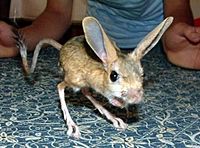Jerboa facts for kids
Quick facts for kids JerboaTemporal range: Middle Miocene - Recent
|
|
|---|---|
 |
|
| Allactaga tetradactyla | |
| Scientific classification | |
| Kingdom: | |
| Phylum: | |
| Class: | |
| Order: | |
| Superfamily: |
Dipodoidea
|
| Family: |
Dipodidae
Fischer de Waldheim, 1817
|
| Genera | |
|
10 genera in 5 subfamilies |
|
A jerboa is a small, hopping rodent that lives in the desert. These animals belong to a group called the family Dipodidae. You can find jerboas in hot deserts across North Africa and Asia, reaching as far as northern China.
When a jerboa needs to escape, it can run very fast. They can reach speeds of up to 24 kilometers per hour (about 15 miles per hour)! Some jerboas are hunted by little owls in central Asia. Most jerboas have excellent hearing. This helps them listen for and avoid predators that hunt at night. A jerboa usually lives for about six years.
Jerboa Behavior
Jerboas have unique ways of moving around. They can hop, skip, and run. Their movements are often fast and change direction quickly. This makes them hard to catch!
Daily Life and Burrows
Jerboas are crepuscular animals. This means they are most active during twilight, which is dawn and dusk. During the hottest part of the day, they stay safe inside their burrows. They leave their burrows at night when the air is cooler.
Jerboas usually dig the entrances to their burrows near plants. These are often found along the edges of fields. During the rainy season, they dig tunnels in mounds or hills. This helps to keep their homes from flooding.
In the summer, jerboas plug the entrance to their burrows. This helps to keep out the hot air. Some scientists also think it helps keep predators away. Most burrows have an emergency exit. This allows the jerboa to escape quickly if a predator finds its way in. Jerboas also hibernate during the winter. They use special permanent burrows for this long winter sleep.
Social Habits and Diet
Jerboas are mostly solitary creatures. Once they grow up, they usually live alone. They also search for their own food. However, sometimes jerboas form "loose colonies." In these groups, some species of jerboas dig burrows together. This can provide extra warmth when the weather is cold.
Most jerboas eat plants. They cannot eat very hard seeds. Some types of jerboas will also eat beetles and other insects they find.
Images for kids
See also
 In Spanish: Dipodidae para niños
In Spanish: Dipodidae para niños


